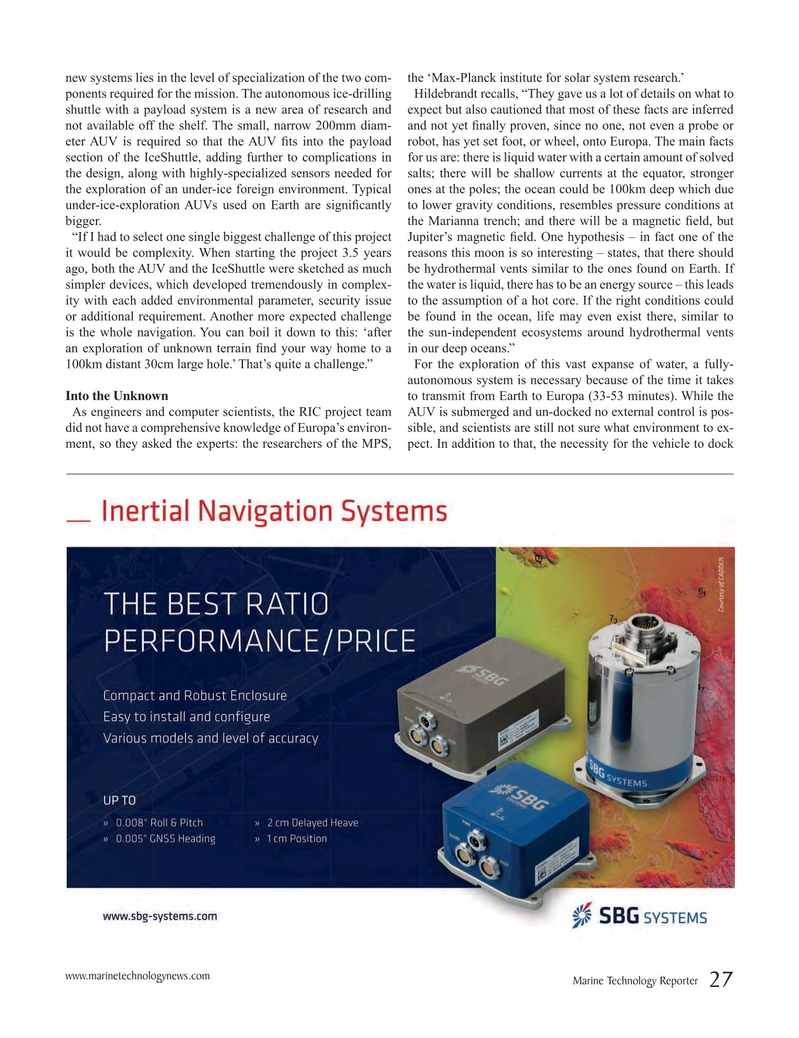
Page 27: of Marine Technology Magazine (October 2016)
AUV Operations
Read this page in Pdf, Flash or Html5 edition of October 2016 Marine Technology Magazine
new systems lies in the level of specialization of the two com- the ‘Max-Planck institute for solar system research.’ ponents required for the mission. The autonomous ice-drilling Hildebrandt recalls, “They gave us a lot of details on what to shuttle with a payload system is a new area of research and expect but also cautioned that most of these facts are inferred not available off the shelf. The small, narrow 200mm diam- and not yet ? nally proven, since no one, not even a probe or eter AUV is required so that the AUV ? ts into the payload robot, has yet set foot, or wheel, onto Europa. The main facts section of the IceShuttle, adding further to complications in for us are: there is liquid water with a certain amount of solved the design, along with highly-specialized sensors needed for salts; there will be shallow currents at the equator, stronger the exploration of an under-ice foreign environment. Typical ones at the poles; the ocean could be 100km deep which due under-ice-exploration AUVs used on Earth are signi? cantly to lower gravity conditions, resembles pressure conditions at bigger. the Marianna trench; and there will be a magnetic ? eld, but “If I had to select one single biggest challenge of this project Jupiter’s magnetic ? eld. One hypothesis – in fact one of the it would be complexity. When starting the project 3.5 years reasons this moon is so interesting – states, that there should ago, both the AUV and the IceShuttle were sketched as much be hydrothermal vents similar to the ones found on Earth. If simpler devices, which developed tremendously in complex- the water is liquid, there has to be an energy source – this leads ity with each added environmental parameter, security issue to the assumption of a hot core. If the right conditions could or additional requirement. Another more expected challenge be found in the ocean, life may even exist there, similar to is the whole navigation. You can boil it down to this: ‘after the sun-independent ecosystems around hydrothermal vents an exploration of unknown terrain ? nd your way home to a in our deep oceans.” 100km distant 30cm large hole.’ That’s quite a challenge.” For the exploration of this vast expanse of water, a fully- autonomous system is necessary because of the time it takes
Into the Unknown to transmit from Earth to Europa (33-53 minutes). While the
As engineers and computer scientists, the RIC project team AUV is submerged and un-docked no external control is pos- did not have a comprehensive knowledge of Europa’s environ- sible, and scientists are still not sure what environment to ex- ment, so they asked the experts: the researchers of the MPS, pect. In addition to that, the necessity for the vehicle to dock www.marinetechnologynews.com
Marine Technology Reporter 27
MTR #8 (18-33).indd 27 9/27/2016 1:53:29 PM

 26
26

 28
28
